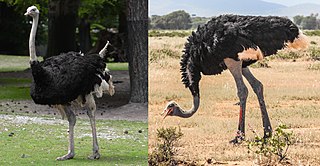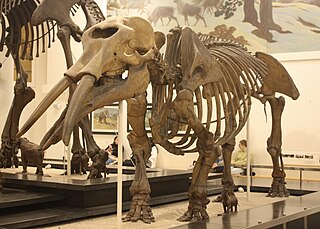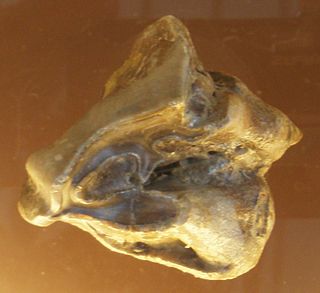
The Miocene is the first geological epoch of the Neogene Period and extends from about 23.03 to 5.333 million years ago (Ma). The Miocene was named by Scottish geologist Charles Lyell; the name comes from the Greek words μείων and καινός and means "less recent" because it has 18% fewer modern marine invertebrates than the Pliocene has. The Miocene followed the Oligocene and preceded the Pliocene.

A pika is a small, mountain-dwelling mammal native to Asia and North America. With short limbs, a very round body, an even coat of fur, and no external tail, they resemble their close relative, the rabbit, but with short, rounded ears. The large-eared pika of the Himalayas and nearby mountains lives at elevations of more than 6,000 m (20,000 ft).

Pseudaelurus is a prehistoric cat that lived in Europe, Asia and North America in the Miocene between approximately twenty and eight million years ago. It is considered to be a paraphyletic grade ancestral to living felines and pantherines as well as the extinct machairodonts (saber-tooths), and is a successor to Proailurus. It originated from Eurasia and was the first cat to reach North America, when it entered the continent at about 18.5 Ma ending a 'cat-gap' of 7 million years. The slender proportions of the animal, together with its short, viverrid-like legs, suggest that it may have been an agile climber of trees.

Rails are a large, cosmopolitan family of small- to medium-sized terrestrial and/or semi-amphibious birds. The family exhibits considerable diversity in its forms, and includes such ubiquitous species as the crakes, coots, and gallinule; other rail species are extremely rare or endangered. Many are associated with wetland habitats, some being semi-aquatic like waterfowl, but many more are wading birds or shorebirds. The ideal rail habitats are marsh areas, including rice paddies, and flooded fields or open forest. They are especially fond of dense vegetation for nesting. The rail family is found in every terrestrial habitat with the exception of dry desert, polar or freezing regions, and alpine areas. Members of Rallidae occur on every continent except Antarctica. Numerous unique island species are known.

Moschidae is a family of pecoran even-toed ungulates, containing the musk deer (Moschus) and its extinct relatives. They are characterized by long 'saber teeth' instead of horns, antlers or ossicones, modest size and a lack of facial glands. While various Oligocene and Miocene pecorans were previously assigned to this family, recent studies find that most should be assigned to their own clades, although further research would need to confirm these traits. As a result, Micromeryx, Hispanomeryx, and Moschus are the only undisputed moschid members, making them known from at least 18 Ma. The group was abundant across Eurasia and North America during the Miocene, but afterwards declined to only the extant genus Moschus by the early Pleistocene.

Platybelodon is an extinct genus of large herbivorous proboscidean mammals related to modern-day elephants, placed in the "shovel tusker" family Amebelodontidae. Species lived during the middle Miocene Epoch in Africa, Asia and the Caucasus.

A rhinoceros, commonly abbreviated to rhino, is a member of any of the five extant species of odd-toed ungulates in the family Rhinocerotidae; it can also refer to a member of any of the extinct species of the superfamily Rhinocerotoidea. Two of the extant species are native to Africa, and three to South and Southeast Asia.

Ostriches are large flightless birds. Two living species are recognised, the common ostrich, native to large areas of sub-Saharan Africa, and the Somali ostrich, native to the Horn of Africa.

Castanopsis, commonly called chinquapin or chinkapin, is a genus of evergreen trees belonging to the beech family, Fagaceae. The genus contains about 140 species, which are today restricted to tropical and subtropical eastern Asia. A total of 58 species are native to China, with 30 endemic; the other species occur further south, through Indochina to Indonesia and the Philippines, mountainous areas of Taiwan, and also in Japan. The English name chinkapin is shared with other related plants, including the golden chinkapins of the Pacific United States, which are sometimes included within Castanopsis but are more often considered a separate but very closely related genus, Chrysolepis.

Eutamias is a genus of chipmunks within the tribe Marmotini of the squirrel family. It includes a single living species, the Siberian chipmunk. The genus is often treated as a subgenus of Tamias, which is now restricted to the eastern chipmunk of North America. Neotamias, which now includes the western North American chipmunks, has also been included in Eutamias.

Gomphotherium is an extinct genus of gomphothere proboscidean from the Neogene of Eurasia, Africa and North America. It is the most diverse genus of gompothere, with over a dozen valid species. The genus is probably paraphyletic.

Indopithecus giganteus is an extinct species of large ape that lived in the late Miocene of the Siwalik Hills in northern India. Although frequently assigned to the more well-known genus Gigantopithecus, recent authors consider it to be a distinct genus in its own right.

Lufengpithecus is an extinct genus of ape, known from the Late Miocene of East Asia. It is known from thousands of dental remains and a few skulls and probably weighed about 50 kg (110 lb). It contains three species: L. lufengensis, L. hudienensis and L. keiyuanensis. Lufengpithecus lufengensis is from the Late Miocene found in China, named after the Lufeng site and dated around 6.2 Ma. Lufengpithecus is either thought to be the sister group to Ponginae, or the sister to the clade containing Ponginae and Homininae.
Miomachairodus is an extinct genus of large machairodontine containing only a single species, Miomachairodus pseudailuroides. It is mainly known from Middle Miocene-age fossils in Turkey and persisted until the early Late Miocene (Vallesian). Fossils of this machairodont have been found in the Vallesian-age Bahe Formation in Shaanxi, China, and Yeni Eskihisar in Anatolia. This Turkish site is of Miocene age and is well known for its pollen studies.

Zygolophodon is an extinct genus of mammutid proboscidean that lived during the Miocene in Africa, Eurasia, and North America.

Hispanotherium is an extinct genus of rhinocerotid of the tribe Elasmotheriini endemic to Europe and Asia during the Miocene living from 16—7.25 mya existing for approximately 8.75 million years.

Ursavus is an extinct genus of bear that existed in North America, Europe, and Asia during the Miocene period, about 23–5.3 million years ago (Mya), existing for roughly 17.7 million years. The genus apparently dispersed from Asia into North America about 20 Mya, becoming the earliest member of the subfamily Ursinae in the New World. Qiu points out that if a questionable 29 million-year-old specimen of Ursavus reported in North America is validated, Ursavus may have evolved in North America and dispersed westward into Asia. The higher number of fossils in Europe grading toward eastern Asia make the westward dispersal unlikely.

Eozygodon is an extinct genus of proboscidean in the family Mammutidae that is based on a single species, E. morotoensis, named in 1983. It is known from the Early Miocene of Africa and well as possibly the Middle Miocene of China. It is considered a primitive member of the family, retaining a long lower jaw (longirostrine) with lower tusks. The upper tusks are small, and are parallel to each other. The skull of the young adult AM 02 from Auchas, Namibia, was around the size of that of a 10 year old American mastodon, around 60 centimetres (2.0 ft) in maximum length. Dental mesowear from East African specimens suggests a browsing diet. Some authors suggest that Eozygodon could be less closely related to other members of Mammutidae than other mammutids are to Elephantida, making Mammutidae as typically defined paraphyletic.

Microstonyx was an extinct genus of suid that existed during the Miocene in Asia and Europe.
Submyotodon is a genus of vespertilionid bats, published as a new taxon in 2003 to describe a Miocene fossil species. Extant species and subspecies previously included in Myotis were later transferred to this genus. Species in this genus are referred to as broad-muzzled bats or broad-muzzled myotises.


























